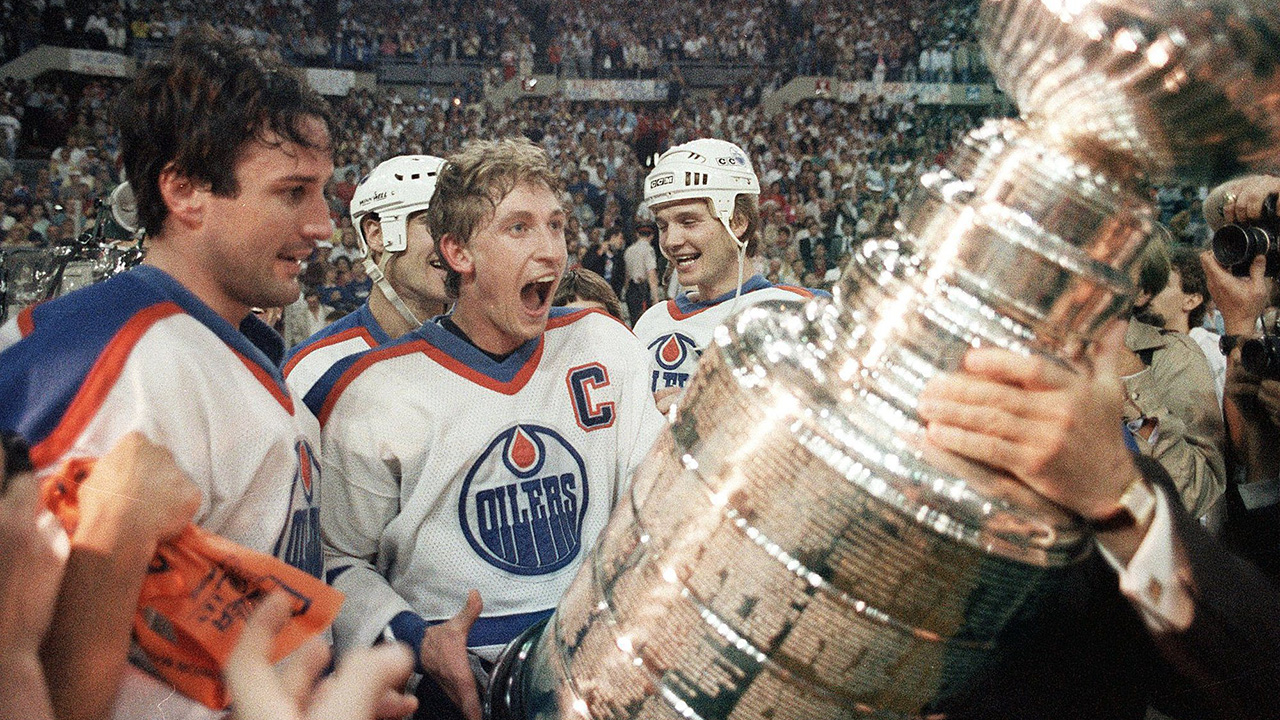One of the biggest stories of the season so far has been the Metro Division. The top five teams are rolling over the rest of the league, and at one point all five were riding long win streaks and pulling away from just about everyone else. There’s really not much question over which division is the league’s best right now.
But which division was the league’s best … ever?
We don’t mean for one year. We’re asking which NHL division was the best of all-time, over the entire course of its existence. And (maybe just as much fun), which were the worst?
Let’s find out. We’ll need a list of distinct NHL divisions, which turns out to be easier said than done. The NHL is constantly tinkering with its format, adding a team here or shifting one over there. If we consider every slight variation to be a brand new division, we’re going to be here forever.
We also can’t rely on their naming conventions since we’ve seen divisions change radically while keeping the same names – the classic 80s Norris didn’t look anything like the initial 1975 version. Then we’d run into what to do with the Atlantic, a name the NHL essentially shifted over to a whole new division a few years ago to make room for the Metro.
Luckily, the NHL’s formatting tends to break down reasonably well into a few, fairly clear eras ranging from a few years long to over a decade of stability. Those break down like this:
– 1968 – 70 (The aftermath of the first expansion)
– 1971 – 74 (Continued expansion)
– 1975 – 81 (The four-division era begins)
– 1982 – 1993 (Classis Norris, Smythe, Patrick and Adams era)
– 1994 – 1998 (Divisions renamed + southern spread)
– 1999 – 2013 (Six-division era)
– 2014 – present (The current format)
That gives us 26 distinct divisions to work with, which is kind of a lot. But hey, nobody does any real work this week, so let’s take a crack at it.
There were no divisions in the Original Six years, so our quest to find the best division starts with the 1967-68 season. As it turns out, that’s where we’ll find the worst one ever.
#26. West Division (1968 – 1970)
Key teams: Blues, Kings, Penguins, Flyers, North Stars, Seals
Cups won: Zero.
The story: The NHL decided to double the size of the league by adding six new teams in 1967, which was mostly good. Then they put all six of those teams into the same division, which was entirely bad, and for three straight years, the West got absolutely destroyed by the established teams in the East.
But because of the idiotic format, the West got to serve up a Stanley Cup finalist each year. The result: three straight sweeps, at which point the NHL finally came to its senses and figured out a better way.
#25. Smythe Division (1975 – 1981)
Key teams: Blackhawks, North Stars, Canucks, Blues, Scouts/Rockies
Other teams: The North Stars headed to the Adams in 1978, while the Oilers and Jets arrive from the WHA in 1979.
Cups won: Zero.
The story: It feels weird to even call this division the Smythe; the Oilers don’t show up until the end, and the Flames are in the Patrick (and Atlanta). It’s probably just as well, because this division was awful.
How bad? It didn’t produce a single team that managed more than 87 points until 1981, when the Blues put up 107. To put that differently, this division had more teams that finished with fewer than 40 points (the 75-76 Scouts and 80-81 Jets) than had more than 90.
But here’s the most amazing fact about the early Smythe: Over six seasons, not only did they never make an appearance in the final, they somehow never even sent a team to the semi-final. That doesn’t seem like it should be possible in a four-division league, but they were that bad.
#24. Southeast Division (1999 – 2013)
Key teams: Capitals, Hurricanes, Lightning, Thrashers, Panthers
Other teams: The Jets remained in the division after relocating from Atlanta. Look, geography has never been a strong point in this league.
Cups won: Two.
The story: God bless the Southeast. As the years wore on, the division became the league’s punchline for mediocrity, if not worse. And sure, part of that was the hockey world’s built-in bias against new markets – the Southeast was basically the Capitals and four relative newbies, so it was easy enough to dismiss the division as the NHL’s island of misfit toys.
But the reputation wasn’t completely unearned. In fourteen seasons together, the Southeast sent the bare minimum one team to the playoffs a half dozen times. And they always seemed to have at least one train wreck; a Southeast team finished dead last overall in six different seasons.
Still, they did win those two Cups, much to the chagrin of the traditionalists. That’s not enough to make up for all the messes that clogged the division for the rest of its 14-season existence, but it’s enough to keep them clear of last spot.
#23. Norris Division (1982 – 1993)
Key teams: Red Wings, Blackhawks, Maple Leafs, North Stars, Blues
Other teams: The Jets were a Norris team for the 1981-82 season before shifting to their rightful place in the Smythe after the Rockies moved to New Jersey. The expansion Lightning joined in time for the 1992-93 season.
Cups won: Zero.
The story: OK, let’s be honest – there’s a strong case to be made for the classic version of the Norris as worst division ever. Not only did they not win a Cup, but it took them almost ten years to even get to the final, and that was a 68-point team that was broken up in a dispersal draft days later. During the 1980s, the Norris was the poster child for the “maybe we let too many teams into the playoffs” argument – the Maple Leafs once made it in with just 52 points.
But still, we have to give a few points for style, and the Norris certainly had that. The style was everyone punching each other, in the face, at all times, which may not have been your cup of tea. But if you wanted old-time hockey, as represented by Bob Probert, Wendel Clark, Joey Kocur and Basil McRae, then the Norris was your division. Rank them lower if you want, but keep your head up afterwards.
#22. West Division (1971 – 1974)
Key teams: Blackhawks, Blues, Kings, Penguins, Flyers, North Stars, Seals
Other teams: The Atlanta Flames joined in 1972.
Cups won: One
The story: The NHL reworked the divisions in 1971, but not much – they basically moved the Blackhawks over to the West to make room for Vancouver and Buffalo in the East. Yes, that’s right, Vancouver was in East while Philadelphia, Pittsburgh and Atlanta were in the West. Did we mention that geography is hard?
Still, the presence of the Blackhawks and the slow but steady improvement of the other teams made the West at least semi-respectable. They finally won their first Cup in 1974 when the Flyers broke through, at which point the NHL scrambled the divisions again
#21. Northeast Division (1994 – 98)
Key teams: Penguins, Bruins, Canadiens, Sabres, Senators, Whalers/Hurricanes
Other teams: The Nordiques were here until they moved to Colorado in 1995. The Whalers became the Hurricanes in 1997, but remained in the division.
Cups won: Zero.
The story: Gary Bettman and the NHL annoyed everyone by changing all the division names in 1993, but by that point the old Adams was already looking different, as two teams were on the verge of relocating and a new expansion team had been added. Mix in a down cycle for the Bruins and Canadiens and the somewhat weird arrival of the Penguins, and this was a forgettable era.
#20. Pacific Division (2014 – present)
Key teams: Shark, Kings, Ducks, Oilers, Flames, Coyotes, Canucks
Cups won: One.
The story: The four current divisions have the deck stacked against them a bit on our list, simply because they haven’t been around all that long. When the NHL finally ditched the six-division format in 2013, fans were given a chance to learn new terms like “crossover wildcard” while welcoming back a more traditional four-division look.
The Pacific is a tricky one. They’ve got a Cup, and have sent a team to the final in two out of three years. But they’ve also been notoriously top heavy, mostly thanks to the three California teams. They’ve produced the minimum three playoff teams in all three years of the new format, and they’ve had eight sub-80 point teams, which is almost more than the rest of the league combined (who’ve had ten).
Check back in a few years, when Connor McDavid, Johnny Gaudreau and friends are in their prime, and maybe it’s a different story. But for now, the Pacific stands as the worst division of the current era.

The Los Angeles Kings Stanley Cup parade in 2014. (Nick Ut/AP)
#19. Northeast Division (1999 – 2013)
Key teams: Maple Leafs, Canadiens, Bruins, Sabres, Senators
Cups won: One.
The story: Chalk it up to the Maple Leafs’ switching conferences and bringing over some of those lingering Norris cooties, but the Northeast just didn’t make all that much noise most years. The Bruins kept the entire division from being held without a Cup, and it took over a decade just to get that. OK, they would have had one more if the NHL had remembered its rulebook, but since when has that ever happened?
Sure, the Senators were a good regular season team for most of this stretch, and even managed to score a Cup-winning goal. But the Canadiens suffered through one of the quietest stretches in their history, the Leafs imploded in a salary cap world, the Bruins became the only team to ever trade an MVP mid-season, and the Senators and Sabres both filed for bankruptcy in the same week.
#18. Atlantic Division (2014 – present)
Key teams: Canadiens, Bruins, Maple Leafs, Sabres, Red Wings, Senators, Panthers, Lightning
Cups won: Zero.
The story: In the three years since the NHL switched formats, the Atlantic is the only division that hasn’t produced a Cup winner. The Bruins did win the Presidents Trophy in 2014 and the Lightning went to the 2015 final, but the division only sent three teams to the playoffs last year and seems on track to repeat that feat this season. They’re also dragged down by having all three last place overall teams, as the Maple Leafs and Sabres tanked their way to the basement.
#17. Pacific Division (1994 – 98)
Key teams: Kings, Flames, Oilers, Ducks, Canucks, Sharks
Other teams: The Avalanche joined the division for the 1995-96 season.
Cups won: One.
The story: The remnants of the old Smythe didn’t do much to carry on that legacy, and it took the arrival of the Avalanche to deliver the division’s only Cup. Nobody else even managed a 100-point season, so despite the occasional nice story, like the Canucks’ near miss in 1994, we can’t rank them all that high.
#16. Adams Division (1975 – 1981)
Key teams: Bruins, Maple Leafs, Sabres, Golden Seal/Barons
Other teams: The North Stars shifted over from the Smythe in 1978 after the Barons went belly up. The WHA’s Nordiques arrive the following season.
Cups won: Zero
The story: They didn’t win a Cup, but this wasn’t a bad division, producing at least one 100-point team every year except 1980-81, when the Sabres topped out at 99. The Bruins and Sabres do most of the heavy lifting, combining for three appearances in the final. The problem, as we’ll see a little further down the list, is that they kept running into unbeatable dynasties.
#15. Northwest Division (1999 – 2013)
Key teams: Oilers, Flames, Canucks, Avalanche, Wild
Other teams: The expansion Wild arrived in 2000.
Cups won: One.
The story: The division won its only Cup in 2001, when the Avs captured the second in franchise history. But they did produce three very near-misses, as the Flames, Oilers and Canucks all got to a seventh game in the final before losing.
Still, with the exception of the expected struggles of the expansion Wild and the later ineptitude of the Oilers, this was a division that for the most part settled into the middle-of-the-pack. Only occasionally strong but rarely awful, there were plenty of seasons where they were mostly just there.

The Colorado Avalanche after winning the Stanley Cup in 2001. (David Zalubowski/AP)
#14. Atlantic Division (1999 – 2013)
Key teams: Penguins, Devils, Rangers, Flyers, Islanders
Cups won: Three.
The story: The Atlantic had a decent run; only one division won more Cups during the six-division format era. They were the home of the Devils, one of the better teams of the pre-Cap era, and later could boast Sidney Crosby and the Penguins.
It certainly wasn’t a great division top-to-bottom, as the Islanders drag things down, the Rangers went through a long stretch without a playoff appearance, and even the Penguins crashed and burned (and nearly moved). But overall, the good outweighed the bad.
#13. Adams Division (1982 – 1993)
Key teams: Canadiens, Bruins, Sabres, Nordiques, Whalers
Other teams: The expansion Senators joined in 1992-93.
Cups won: Two
The story: The classic Adams lineup doesn’t really jump to mind when you talk about great divisions, but this was a sneaky-good collection of teams. The Canadiens won two Cups, the Bruins got to two finals, the Sabres had their moments, and the Nordiques’ rivalry with the Habs was one of the best ever. Even the division’s perpetual also-rans, the Hartford Whalers, were a lovable underdog with a catchy theme song.
A great division? Not necessarily. But they were more fun than you remember.
#12. Atlantic Division (1994 – 98)
Key teams: Rangers, Devils, Islanders, Flyers, Capitals, Lightning, Panthers
Cups won: Two.
The story: The good: the division provided Cup winners in 1994 and 1995. The former was one of the most memorable of all time, as Mark Messier’s Rangers ended a 54-year drought, and the latter marked the ascension of the Devils to an elite status they’d hold for a decade.
The bad: The Islanders were largely awful, and the expansion Lightning and Panthers didn’t do much beyond Florida’s surprise run to the 1996 final.
The ugly: Fair or not, this is the division we typically blame for the birth of the Dead Puck Era. Between the ’95 Devils’ trap and the ’96 Panther’s clutch-and-grab, the original Atlantic was ground zero for some dreadful hockey.
#11. Central Division (1994 – 98)
Key teams: Red Wings, Maple Leafs, Blackhawks, Blues, Stars, Jets/Coyotes
Cups won: Two.
The story: The Blackhawks weren’t bad, the Maple Leafs had a few runs, the Stars were building an eventual champion, and the Blues were at least crazy enough to bring Wayne Gretzky to the division for a few weeks.
But really, this division belonged to the Red Wings. They made three appearances in the final, won two Cups, had an eye-popping 131-point season, and found time to launch the last great rivalry in NHL history. Not bad for a half-decade’s work, although not quite enough to crack the top ten.
#10. Metro Division (2014 – present)
Key teams: Rangers, Flyers, Devils, Penguins, Capitals, Blue Jackets, Hurricanes, Islanders
Cups won: One.
The story: They have the league’s best player, its biggest US market, and its dumbest name. With one Cup and two Presidents’ Trophies, the Metro also has more hardware than any other current division. And that’s not even counting this year’s Blue Jackets, who’ll finish the season on a 62-game win streak before sweeping the playoffs.
Is that enough to give them top billing among today’s mix? Not quite, as we’ll see a few spots below, but it’s close.
#9. Pacific Division (1999 – 2013)
Key teams: Kings, Sharks, Ducks, Coyotes, Stars
Cups won: Three.
The story: The Stars owned this division for the first half-dozen years or so, including a Cup win. They eventually gave way to the Sharks and Ducks, and when the Kings finally re-emerged towards the end we were left with a Battle of California that stood as perhaps the best three-way rivalry in the sport.
The division only managed four trips to the final, but they won three of them, and their one loss at least served up an iconic moment.
#8. Central Division (2014 – present)
Key teams: Blackhawks, Blues, Wild, Stars, Avalanche, Predators, Jets
Cups won: One.
The story: The Central has been consistently strong for all three years under the current format, producing five playoff spots and at least three 100+ point teams every year. They’ve been so good that a team generally considered among the league’s very best, the Blackhawks, has never actually finished higher than third place. Heck, the division is so good that last year they got bored and decided to start winning playoff rounds in the Pacific.
Given all that, it’s a mild surprise that the Central hasn’t produced more than one appearance in the Cup final. Maybe you chalk that up to how hard the road out of the division really is, or maybe you just shrug it off as the randomness of today’s playoffs. But that and the relatively small timeframe we’re working with is enough to keep the Central from ranking as high on our list as you might expect.
#7. Patrick Division (1982 – 1993)
Key teams: Islanders, Rangers, Flyers, Penguins, Capitals, Devils
Cups won: Four
The story: Being the era’s only six-team division gave the Patrick an uphill climb, but they brought home two Cups by the Islanders at the start of this window and two more by the Penguins near the end. In between, we got the Flyers coming agonizingly close against the Oilers, a long stretch of disappointment from the Rangers, the start of the Capitals’ legacy of blowing series leads, and the Devils’ “Mickey Mouse” era. But we also got Mario Lemieux in his prime. A mixed bag, sure, but far more good than bad.
#6. Norris Division (1975 – 1981)
Key teams: Canadiens, Red Wings, Penguins, Kings, Capitals
Other teams: The WHA’s Whalers joined the division in 1979, bumping the Capitals over to the Patrick.
Cups won: Four
The story: On the one hand, this division really only had one truly exceptional team. On the other, that one team was the Montreal Canadiens, who were right in the middle of their last great dynasty. Those Habs teams were some of best ever, period, winning four straight Cups and at one point losing 29 regular season games total over three full seasons from 1975-78. (Every other team in the division lost at least 29 in each and every year during that span.)
So sure, the Canadiens were amazing. But one team can only account for so much, and the rest of the division’s also-rans pull this division out of contention for a top five spot.

Montreal Canadiens celebrate winning the Stanley Cup in 1979. (AP Photo)
#5. East Division (1971 – 1974)
Key teams: Canadiens, Bruins, Red Wings, Maple Leafs, Rangers, Sabres, Canucks
Other teams: The expansion Islanders joined in 1972.
Cups won: Three
The story: Losing the Hawks and having three expansions teams watered down the one-time powerhouse, but they still put up nine 100+ point seasons over five years. The Bruins and Habs traded Cups early on, and this was during Bobby Orr’s prime and the early years of Ken Dryden, so it was a fun division to watch, at least at the top end.
#4. Central Division (1999 – 2013)
Key teams: Red Wings, Blues, Blackhawks, Predators
Other teams: The Blue Jackets arrive in 2000.
Cups won: Four.
The story: There aren’t any dynasties in the NHL anymore, but this division served up two of the closest facsimiles we’ve seen, as the Red Wings eventually gave way to the Blackhawks as multi-Cup powerhouses. The rest of the group drags it down a bit, as we had two expansion franchise and a normally dependable Blues team that hit rock bottom in 2005-06. Still, two mini-dynasties out of five isn’t a bad batting average.
#3. East Division (1968 – 1970)
Key teams: Canadiens, Bruins, Red Wings, Maple Leafs, Blackhawks, Rangers
Cups won: Three
The story: You may know these teams as The Original Six. In the late 60s, hockey fans knew them as “the teams that win every year because the NHL put all the terrible expansion teams into the same division”.
If we’re just looking at wins and losses, this division has a strong claim at best-ever status; there’s really no question that it was the most dominant division of all time, sweeping every Cup final of the era. But given the short three-year run and the degree of difficulty – i.e. virtually zero – they’ll have to settle for bronze.
#2. Patrick Division (1975 – 1981)
Key teams: Islanders, Rangers, Flyers, Flames
Other teams: The Capitals arrive in 1979.
Cups won: Three
The story: This was largely a two-team division, as the Broad Street Bully Flyers slowly gave way to the Islanders dynasty. The Flyers won the Cup in 1975, while the Islanders won two of what would end up being four-straight in 1980 and 1981. There was no Presidents’ Trophy back then, but if there was then the Flyers and Islanders would have combined to take three straight, and been tied for top spot in another year.
Maybe even more impressively, the Patrick even managed the rare feat of supplying both teams in the 1980 Cup final, when the Isles beat the Flyers thanks to the NHL’s weird playoff format.
Not surprisingly, the other teams struggled to keep up with those two powerhouses. The Rangers did make the 1979 final, although they didn’t get much respect for it – that was the year that the Canadiens and Bruins’ too-many-men matchup was considered the “real” final because everyone knew the Rangers would get pummeled (they did).
But in general, this was a consistently good division, often from top-to-bottom. No season made that clearer than 1978-79, when all four teams finished with 90 points or more; only two other teams in the rest of the NHL cracked that mark that year.
#1. Smythe Division (1982 – 93)
Key teams: Oilers, Flames, Kings, Canucks, Jets
Other teams: The Colorado Rockies were here through the 1981-82 season. The expansion Sharks appeared for the 1991-92 season.
Cups won: Six
The story: The six Cups came in a seven-year span, interrupted only when the Oilers decided to start shooting pucks into their own net. The division also won the first four Presidents’ Trophy, and sent a team to the Cup final for nine straight years.
And sure, much of that was done by Wayne Gretzky and the Oilers, the last great dynasty the NHL will probably ever see. But what sets the classic-era Smythe apart from other divisions that were dominated by one team is the way that other teams responded. The Flames’ desperate attempt to catch up with their provincial rivals was one of the best stories of the 80s, one that was finally capped off by a Cup win in 1989. The Kings eventually went out and got Gretzky in an attempt to make their mark, reaching the final with him in 1993. And even the Canucks and Jets had more moments than typical also-rans.
Factor in a boatload of future Hall-of-Famers and the division’s breathtaking run-and-gun style, and we have our winner. Other divisions can make a case, but the classic 1980s Smythe Division stands as the greatest of all-time.










